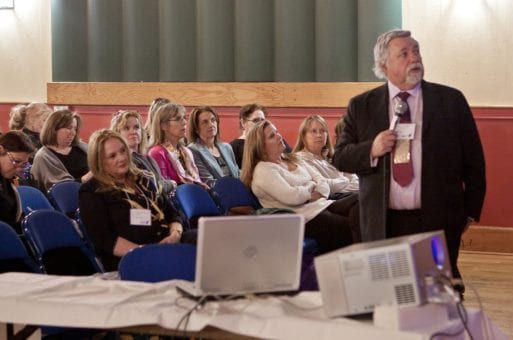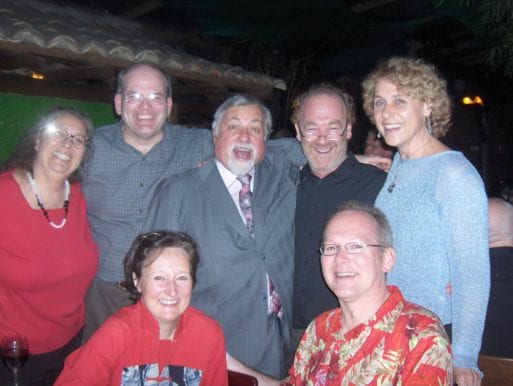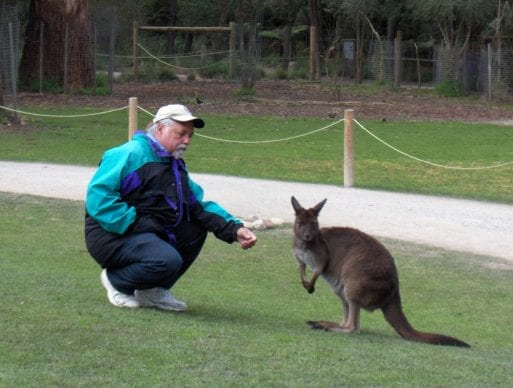“When you were 10 years old, did you dream that you’d grow up to study death and dying?”
Dr. Ken Doka‘s son loves to tease him with this question. The obvious answer, says Doka, is no; in fact, even as an adult, he never thought he’d go into gerontology. In the ’70s, he was training to be a Lutheran minister while pursuing a master’s degree in clinical sociology. He wanted to work with juvenile delinquents.
As often happens in life, however, Dr. Doka’s plans took a detour — one that eventually led him to become a professor of gerontology at The College of New Rochelle, an incredibly prolific author, editor, and speaker, and a leading voice in the study of various types of grief and loss. Dr. Doka introduced the idea of “disenfranchised grief,” a concept that is now widely recognized in counseling and research fields.

Dr. Doka presenting at a workshop
The term “disenfranchised grief” has helped to open up a conversation around the many types of grief that are not socially recognized. This concept has hit home for the many grievers who have found guidance through Dr. Doka’s work on the subject, including our founder, Suzette Sherman. Suzette has shared her own story of dealing with disenfranchised grief after her husband of 20 years came out as gay. As with many types of grief and loss, there were few resources available to help her cope with this specific experience.
Though Dr. Doka has retired from teaching, he keeps a busy schedule of writing, consulting, and speaking at various conferences (when they haven’t been canceled due to a certain pandemic, of course). When we spoke, he had just finished up a chapter in his new book. Today we will explore with him the five types of disenfranchised grief as well as the types of reactions people experience.
Editor’s note: This interview has been edited for length and clarity.
Dr. Doka, we’re honored to have the opportunity to speak with you today. First, I’d like to ask — what brought you to the field of grief and dying?
In the ‘70s, I was in seminary full-time to be a Lutheran minister, but I was also going full-time to grad school at St. Louis University for clinical sociology. Trying to coordinate going to two schools wasn’t easy. In the summer of 1971, I had to fulfill my clinical pastoral education quarter, which involved working an onsite, intensive program for three months. I was supposed to do an internship at the Spofford Juvenile Center in New York City, which held juvenile delinquents prior to trial. I was very excited — that was the internship I wanted, and it fit in perfectly with my plans.
Then, a week before the internship started, I got a letter from my prospective supervisor telling me he’d changed positions, and the program I was signed up for no longer existed. However, I had the choice of coming with him to the East Midtown Protestant Chaplaincy to serve at a number of hospitals in New York. I had no interest in doing that, but my whole academic plan pretty much demanded it. I figured, “I’ll do it — you can do anything for three months.”
Having done a lot of work with adolescents and kids, I thought this would be a good experience for me, something new. But when I got there, the supervisor said, “You’re just the person we need for pediatrics.”
I was working in pediatrics at Sloan Kettering, the cancer center. The first day I walked in — I’ll never forget this — the playroom was closed that day, so all the kids were in the lobby as soon as I got out of the elevator. Some were amputees. Some had very visible tumors, some were bloated from chemo, some emaciated. For one of the few times in my life, I felt an overwhelming sense of panic. Finally, I calmed down and thought to myself, “Just get through this.” I figured I could always drop it later if it was too much.
But I kept coming back, and after about a week, I saw the kids, not the disease. It turned out to be a life-changing experience. I wrote my master’s thesis for grad school on terminal care in pediatric hospitals, and my master’s thesis for the seminary was about a dying child and their family.

Dr. Doka at a conference with colleagues
Your concept of disenfranchised grief has been very influential in this field. What are the different types of disenfranchised grief? What are some examples?
The original research was about grieving the loss of ex-spouses. The people dealing with disenfranchised grief are those who have experienced a loss that’s not acknowledged by others; essentially, it’s a type of grief that is not socially recognized — not openly supported, not well understood. It means you had a significant loss but didn’t have the support from others that you would normally have. It literally means you aren’t given the right to grieve.
There are five types of disenfranchised grief. The first is when the relationship isn’t acknowledged. That would include ex-spouses or people involved in significant unmarried relationships. For instance, what happens when the person you’re living with or even having an affair with dies? It could also be the loss of a teacher or a coach — any loss where a relationship is not recognized.
Then, there’s cases where the loss itself isn’t recognized, like when a person is experiencing grief from divorce. In 1917, Freud wrote “Mourning and Melancholia,” which is where most of us would say modern grief studies began. That was the first time there was a psychological interest in the grief process. And in that work, Freud used the case study of a bride abandoned at the altar rather than a death. He was trying to remind us that death is not the only form of loss.
The third type of disenfranchised grief occurs when the griever is not acknowledged. The griever may have developmental disabilities or may be very old or very young. I’ve done a lot of work with people who had intellectual disabilities — often, their sense of loss is ignored because people think they don’t understand what’s happening, but they do.
Those were the original three types of disenfranchised grief. Over time, we added two more. There were cases where, for example, there was stigma attached to the death, such as with suicide or addiction. In those cases, people don’t look for support, or they’re embarrassed. One of the women I interviewed had a son who died when he was shot in a robbery — and he was the robber. When people asked her how her son died and she said he was killed in a robbery, they would say, “I hope they got that bastard.” She never knew what to say, because he was “that bastard.”
In the fifth category of disenfranchised grief, the person’s grief process doesn’t fit with the norms of society. I’m half Hispanic on my mother’s side, and when my grandmother died, a number of Hispanic friends came to the funeral and literally wailed, loudly and openly. Some people weren’t used to it and got embarrassed — but that was their way of mourning. And after all, it may have been what my grandmother wanted, and no one else would do it for her.
In your work, you’ve pointed to different styles of grieving. What are some examples of different types of disenfranchised grief reactions? Are some healthier or more effective than others?
This exploration of grieving styles started as a study on gender — we wanted to determine whether people of different genders experience grief differently. What we found is that gender is just one factor in how people grieve. Culture is another factor, and socialization experiences affect grieving too. That study was where we began to identify the different grieving styles.
The grieving style that most of us are familiar with is intuitive grieving. When you ask an intuitive griever how they experience grief, they talk about waves of emotion. When they express that emotion, it’s by showing it — crying, weeping, shouting, screaming. What helps them is often to talk to someone, to get their feelings out and explore them.
On the other side of the continuum is the instrumental griever. They experience grief more cognitively or physically. If you ask them, “What was it like when this person died?” They’ll say, “I kept thinking about them,” or, “I couldn’t think at all, I was so confused and disoriented.” Or, “It felt like someone punched me.” They express their grief by reminiscing or talking about the person who died, or by doing something.

Dr. Doka makes a new friend
For instance, I had a client once whose 16-year-old daughter died in a car crash. Her car turned over on an icy road coming home and broke the neighbor’s picket fence. On the day of the funeral, the father went out and fixed the fence. The neighbor came running out to him, saying, “You don’t have to do this,” and he said “No, I do. This is the only part of the accident I can fix.” That’s an example of the instrumental grief process.
There are also blended grievers, who have different types of grief reactions for different losses. The fourth grieving style is dissonant grieving, and that’s when someone has an emotional reaction but represses it, perhaps because they want to appear strong.
On that note, what’s the difference between grieving in your own way and repressing your grief?
Generally, that’s a question that we answer by exploring how that person copes with other stresses in their life. I’ll use a Seinfeld episode as an example. When Jerry is dating Bette Midler’s understudy, she bursts into tears over the smallest thing, like dropping her hot dog. But when she gets the news that her grandmother is dead, she has no reaction. That would be the kind of thing we look for — when a person is not engaging in their usual coping style. Grieving or dealing with loss is dealing with stress. Loss is a stressful event. How we cope is usually pretty consistent. You can tell when someone is more emotion-based in their coping style or more problem-focused or spiritually based.
The other thing is that people who are truly instrumental can talk about their loss. They can’t talk about it in emotional terms, necessarily, but they can talk about it. They might say, “I love Grandma, she used to make this great hot chocolate whenever she babysat.” But if you’re repressing, you don’t want to talk about things like that.
How do you think our healthcare system can accommodate a more diverse range of grieving styles and needs?
We need more training. A study came out a few years ago that indicated that many health professionals are still using the “stages of grief” paradigm to explain the grief process. I think healthcare workers need to be educated on some more current grieving concepts. The stages paradigm needs to be acknowledged as an important first step — I used to teach it in classes for its historical significance — but one of the ways that the field of grief has changed is that we no longer look for predictable patterns. There are individual variations in the grief process.
In my honest opinion, we have to recognize the stages paradigm for its historical importance, and then go on to more contemporary studies. If I was interviewing a professor and he referred to the stages, the interview would be done. It was an original approach, but it’s 50 years old. There is no empirical grounding to the five stages — there never was.
How do you think COVID-19 has impacted our grief processes?
I think there is a coming pandemic of complicated grief. COVID-19 has led to really complicated, unpredictable deaths that are often very sudden, within a few weeks. People are dying isolated. Funeral rituals are limited. There are a lot of complicating factors here, not for COVID-19 alone but for all deaths. If your father is dying of cancer and is in a nursing home or hospital, you can’t visit because of COVID-19.
Another factor is that non-COVID deaths have become disenfranchised. I saw the same thing happen when my aunt died on Sept 12, 2001. She was 92 years old and died in bed at home, very quietly and peacefully, surrounded by her children. When I mention the funeral, everyone says, “Did she die in 9/11?” and when I say no, they lose interest.
My aunt’s priest gave the service at her funeral, but I gave the service at her grave; my family jokes that there was a funeral service and then a rebuttal at the graveside. The priest had said, “This is not one of these tragic deaths.” Yes, she died at 92, and she died peacefully, but to us, it was still a tragic death. At times like these, society doesn’t give people grieving other deaths the same level of acknowledgment and support. Now, we are seeing non-COVID deaths becoming less significant.
Thank you so much for taking the time to speak with us today. It’s been a pleasure to learn more about your work.

 Disenfranchised Grief: The Five Types and Reactions Explained
Disenfranchised Grief: The Five Types and Reactions Explained


 First the Wealth Gap, Now the U.S. Has a Growing Health Gap
First the Wealth Gap, Now the U.S. Has a Growing Health Gap

 Our Annual Seven Holiday Gifts for Someone Who Is Grieving, 2024 Edition
Our Annual Seven Holiday Gifts for Someone Who Is Grieving, 2024 Edition














